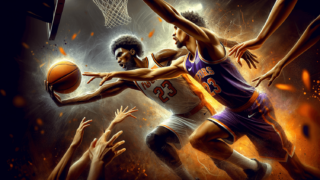
Welcome to the exciting world of basketball strategy! In this blog post, we’ll be shedding light on the dynamic tactics of the “pick and slip,” a maneuver that has become increasingly popular among players who desire to create mismatches and easy scoring opportunities. With a combination of finesse, timing, and teamwork, this on-court marvel allows players to outmaneuver their opponents and keep fans on the edges of their seats. So, whether you’re an avid hoops fan or just curious about all things basketball, sit back, relax, and let’s dive into the intricacies of the basketball pick and slip!
What’s a Basketball Pick and Slip?
A basketball pick and slip is an offensive play where a player sets a screen (the pick) for a teammate with the ball and then quickly moves (slips) towards the basket. This action creates space and a potential mismatch, facilitating an open shot or easy pass for a scoring opportunity.
Understanding the Basics: The Pick and Roll vs. Pick and Slip
Before delving into the specifics of the pick and slip, let’s distinguish it from its well-known counterpart, the pick and roll. Both plays involve an offensive player setting a screen (the “pick”) for the ball handler, but they differ in the subsequent movement of the screener. In a pick and roll, the screener moves towards the ball handler to receive a pass, while in a pick and slip, the screener darts towards the basket in hopes of a quick scoring opportunity. Though similar in nature, understanding this distinction can greatly enhance one’s appreciation for the strategic value of the pick and slip in the game of basketball.
Breaking Down the Pick and Slip: Step by Step
Now that we’ve differentiated between the pick and roll and the pick and slip, let’s explore the pick and slip play in more detail. Here are the fundamental steps involved in executing this offensive maneuver:
Step 1: Selection of the Screener
Choose a player to set the screen—ideally, someone with good size and agility, capable of both setting strong screens and rapidly cutting to the basket.
Step 2: Positioning the Screener
The designated screener positions themselves near the defender guarding the ball handler, standing with a wide base, feet shoulder-width apart, and hands ready to protect against any potential contact. As they make contact with the defender, it’s essential for them to remain stationary to avoid being called for a moving screen.
Step 3: Initiating Contact with the Defender
As the ball handler moves towards the screener, they should aim to brush closely past the screener. This proximity will make it more difficult for the defender to maneuver around the screen, increasing the chances of success for the pick and slip play.
Step 4: Executing the Slip
Once the ball handler has passed the screener, the screener should immediately move towards the basket, staying low and explosive to maximize their speed advantage. This movement (the “slip”) will ideally capitalize on a sudden time and space advantage, as the opposing defense scrambles to rotate and adjust to the developing play.
Step 5: Facilitating the Pass
As the screener slips toward the basket, the ball handler needs to read the defense and determine the best course of action. If the screener’s defender is slow to react or switches onto the ball handler, the ball handler should deliver a timely and accurate pass to the slipping teammate, who can then finish at the rim or capitalize on the mismatch.
Why Utilize the Pick and Slip?
The pick and slip functions as an offensive weapon to exploit defenders’ anticipation of the more common pick and roll. It can catch the defense off guard, as they often expect the screener to move towards the ball handler rather than directly to the basket. In such cases, the pick and slip can generate easy scoring opportunities and uncontested shots. Additionally, it serves to create and exploit mismatches, as smaller guards can sometimes end up guarding larger post players, providing opportunities for easy scores and rebounds.
Common Pick and Slip Scenarios
Although possible in most offensive sets, the pick and slip thrives in specific scenarios. A few such examples include:
1. Anticipating a Defensive Switch
If a team frequently switches screens, the slip can be employed to catch defenders off balance. Instead of waiting for the switch and potentially being stuck in an unfavorable matchup, the screener slips to the basket, creating confusion and forcing defenses into split-second decisions.
2. Exploiting Defensive Overcommitment
When a team’s defensive strategy involves aggressive help defense or “hedging” on the pick and roll—meaning they overcommit to stopping the ball handler—the pick and slip can be highly effective. By slipping to the rim quickly, the screener forces the defense to choose between forfeiting an easy pass to the basket or leaving the ball handler uncontested on the perimeter.
3. Targeting Mismatches
If a specific player or matchup provides a significant size or speed advantage, the pick and slip can exploit these differences. For example, if a smaller guard is matched up with a taller forward, the forward can slip to the basket after setting the screen, creating an interior scoring opportunity against the smaller defender.
Defending Against the Pick and Slip
In order to counter the pick and slip, defenses need to stay disciplined and communicate effectively. Here are three defensive principles to consider:
1. Recognize the Play Early
Defenders must be alert for signs of a potential slip, such as when the screener begins moving immediately after making contact with the defender. Knowing the play in advance allows defenders to react quickly and adopt appropriate defensive adjustments.
2. Strong Defensive Rotation
If the defense gets caught in a slip, effective rotation onto the slipping player is vital. A help side defender should “tag” or briefly pick up the slipping player, either stopping their path to the basket or providing enough resistance for the initial defenders to recover and reestablish their assignments.
3. Communication is Key
Defenders must communicate with each other throughout the play. A simple callout of “slip” can alert teammates to adjust their position and counter the offensive threat. Good communication minimizes confusion, reduces breakdowns, and maintains defensive integrity.
Notable NBA Stars and the Pick and Slip
Many NBA stars have utilized the pick and slip to their advantage throughout their careers, mastering the art of this offensive weapon. Some notable examples include:
1. Tim Duncan
With his size, intelligence, and soft touch around the basket, Tim Duncan maximized the effectiveness of the pick and slip while playing for the San Antonio Spurs. Duncan’s superior basketball IQ enabled him to read the defense and slip to the basket at precisely the right moment, making him a consistent threat with this tactic.
2. Dirk Nowitzki
The seven-foot forward’s exceptional skills made him a dual threat when executing the pick and slip. Dirk Nowitzki’s height gave him an advantage inside, while his uncanny shooting range meant that defenders had to respect his ability to slip both to the paint or the three-point line—a true pick and pop artist.
3. Draymond Green
Draymond Green’s versatility makes him a potent pick and slip threat. As a member of the Golden State Warriors, Green frequently capitalized on both mismatches created by the slip and the chaos it caused within opposing defenses. His superb passing abilities also made him a formidable weapon when initiating the play as the ball handler, utilizing teammates like Stephen Curry and Klay Thompson to set screens and slip to the basket.
Sharpening Your Pick and Slip Skills
While the pick and slip is a potent offensive tool, its success relies on practice, timing, and teamwork. Whether you’re a coach or a player, here are a few tips for honing your pick and slip expertise:
1. Practice Makes Perfect
Incorporate the pick and slip into your team’s offensive drills, focusing on timing, accuracy, and communication between the screener and the ball handler. Frequent repetition helps develop a feel for the play and enhances on-court execution.
2. Film Study
Study game tape to identify tendencies in your team’s execution of the pick and slip, as well as your opponents’ defensive responses. Recognizing patterns can help reveal potential areas for improvement and uncover previously unnoticed scoring opportunities.
3. Develop Individual Skills
For the pick and slip to be truly effective, the players involved must possess the necessary skills to exploit any resulting mismatches. This may include improving one’s ability to finish in the paint, enhancing post moves, or developing a more accurate outside shot to keep defenses guessing.
With a thorough understanding of the basketball pick and slip, players, coaches, and fans alike can appreciate the strategic nuances of this exhilarating offensive maneuver. Add this tool to your basketball arsenal and watch the points rack up!
Additional Tips for Perfecting the Pick and Slip
Having established a strong foundation of understanding and execution, here are some extra tips to really make the most of the basketball pick and slip offense:
Master the Art of the Fake Slip
A fake slip is a variation where the screener appears ready to slip but instead finishes setting the screen. If the screener’s defender hesitates in anticipation of the slip, it gives the ball handler a better chance to create a scoring opportunity or pass the ball to the screener. Practicing this deceptive maneuver will keep your opponents guessing and increase your overall offensive effectiveness.
Improve Your Passing Aptitude
Executing the pick and slip’s final pass to a high standard requires quick decision-making and accurate passes from the ball handler. Strengthening your ability to read defenses and deliver common passes like bounce passes or lobs can significantly elevate the success rate of this play.
Utilize the Pick and Pop
The pick and pop is similar to the pick and slip, but involves the screener moving to an open spot on the perimeter after setting the screen, rather than towards the basket. Combining the pick and slip with this complementary tactic keeps defenses on their toes, as they have to account for the possibility of both strategies. Developing a reliable jump shot as a screener will also increase your value as a pick and slip/pop player.
More Defensive Strategies for Thwarting the Pick and Slip
To maintain the balance between offensive and defensive skills, here are some additional defensive principles worth noting:
Fight Through the Screen
As a defender, fighting through the screen and staying close to the ball handler can shorten the time it takes to recover from the pick, thus reducing the effectiveness of the pick and slip. Practicing footwork and developing good anticipation skills are essential to improving your ability to fight through screens.
Deny the Pass
After a successful slip by the screener, denying the pass to the slipping player is crucial to stopping the play. Extending your inside arm, staying low, and maintaining pressure on the ball handler can disrupt the pass and force turnovers or bad passes. This requires good positioning, anticipation, and agility on the part of the defender.
Coordinate with Teammates
An effective defensive strategy against the pick and slip involves intricate teamwork beyond just communication. For example, “icing” the pick and roll involves the defender guarding the ball handler directing them away from the screen while a help defender covers the paint to prevent the slipping player from getting an easy basket. Developing such defensive schemes can ensure that your team stays prepared for the pick and slip offense.
By implementing these tips and mastering the various elements of the pick and slip, you’ll become a valuable asset in your team’s offensive strategy. Similarly, understanding how to counter this play on defense is crucial for overall success on the basketball court. So use these insights to step up your game and become a hoops expert!
FAQ Section: Pick and Slip Queries Answered
This FAQ section aims to address some common questions regarding the basketball pick and slip tactic. Whether you’re a player, coach, or just an avid basketball enthusiast, these answers will help you gain a better understanding of this versatile offensive play.
1. Why is the pick and slip used instead of a pick and roll?
The pick and slip is used as an alternative to the pick and roll to catch the defense by surprise or exploit their anticipation of the more common pick and roll. It can lead to easy scoring opportunities and uncontested shots, as well as create and exploit mismatches.
2. Can centers execute the pick and slip?
Yes, centers can execute the pick and slip. In fact, agile and versatile big men often excel in this play as their size, strength, and quickness create mismatches and can lead to high-percentage shots.
3. How does the pick and slip help create mismatches?
When the screener slips to the basket, the defense must rapidly adjust and often switch defenders. This can result in smaller guards having to guard larger post players or slower defenders getting caught on quicker offensive players, thus creating mismatches.
4. Is the pick and slip effective at all levels of basketball?
Yes, the pick and slip is effective at all levels of basketball, from amateur to professional leagues. As long as the appropriate techniques, timing, and teamwork are mastered, this play can be a valuable offensive asset for any team.
5. Can a team use the pick and slip too often?
As with any offensive tactic, relying too heavily on the pick and slip can make a team’s offense predictable. It’s important to have a balanced offensive attack that incorporates various plays and strategies, including the pick and roll, pick and pop, and isolation plays, among others.
6. How important is communication in executing the pick and slip?
Communication is crucial in executing the pick and slip. The screener and ball handler must be on the same page regarding the play’s timing and execution, and teammates must be ready to make adjustments based on how the defense reacts.
7. Can the pick and slip lead to turnovers?
Yes, the pick and slip can lead to turnovers if the ball-handler and screener are not in sync or if the defense reads the play well. Proper technique, timing, and communication can help minimize the risk of turnovers during this play.
8. Is there a “slip” version of the pick and pop?
While the pick and slip usually involves the screener cutting towards the basket, the pick and pop involves the screener moving to an open spot on the perimeter after setting the screen. The slip variation of the pick and pop isn’t as common, but a well-timed fake slip, followed by a pick and pop, can catch the defense off guard and create a mismatch.
9. How can the pick and slip be used against aggressive defensive switching?
If a team frequently switches screens, the slip can be employed to catch defenders off balance. The screener slipping to the basket creates confusion and forces the defense to make split-second decisions, often leading to scoring opportunities.
10. What skills should I focus on to become a better pick and slip player?
To become a better pick and slip player, you should work on various skills such as improving your ability to finish in the paint, enhancing your post moves, developing accurate outside shooting, and mastering the art of setting effective screens. For those involved in facilitating the play, honing your passing abilities and defensive reading skills is crucial to success.
Featured Posts
- No pillar pages found.





